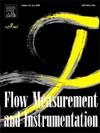Improved discharge prediction models for flow measurements using Central Baffle Flumes
IF 2.3
3区 工程技术
Q2 ENGINEERING, MECHANICAL
引用次数: 0
Abstract
Flow measurement in open channels using mobile or portable flumes is an effective solution for accurate discharge predictions. Researchers have developed various models using dimensional analysis, primarily considering upstream flow depth (y1) and flume geometric parameters. The present study aims to improved discharge prediction models by incorporating the effect of critical depth (yc) and ensuring applicability to both conical and cylindrical baffles. By studying flow through a Conical Central Baffle Flume (CBF) in trapezoidal channels, the research utilizes experiments and CFD-based simulations to gather data from six Conical CBFs with varying discharges. Applying Buckingham's π-method, two new discharge prediction models have been developed and calibrated. These discharge models include upstream flow depth and flume's geometric parameters as key influencing variables, while the effect of critical depth is incorporated through these key influencing variables (i.e. y1, B, D, and c). The first model showed an absolute mean relative discharge error of 1.84 %, while the second model exhibited absolute mean relative errors of 1.99 %. Given the geometric similarity between conical and cylindrical baffles, these models were also validated for their use with Cylindrical CBFs, to confirm their broader applicability. Both the developed models were evaluated using statistical indices (RMSE, RME, PBIAS, and NSE), and as the first model is found to be more accurate, it has been proposed to estimate flow rate. The comparison of the developed models with existing models from the literature for both Conical and Cylindrical CBFs demonstrated that the proposed discharge model (Discharge Model-1) exhibited lower mean relative error in predicting flow rates. The study concludes that incorporating the effect of critical depth in development of models improves discharge prediction accuracy, making these models valuable for field engineers using both Conical and Cylindrical CBFs in trapezoidal channels with side slopes ranging from 0.5 to 1.5, for flow rate measurements.
改进了中央挡板水槽流量测量的流量预测模型
在明渠中使用移动或便携式水槽进行流量测量是准确预测流量的有效解决方案。研究人员利用量纲分析开发了各种模型,主要考虑上游流深(y1)和水槽几何参数。本研究旨在通过纳入临界深度(yc)的影响来改进流量预测模型,并确保对锥形和圆柱形挡板的适用性。通过对梯形通道中锥形中央挡板水槽(CBF)的流动进行研究,利用实验和基于cfd的模拟方法收集了6个不同流量的锥形中央挡板水槽的数据。应用Buckingham π法,建立并标定了两个新的放电预测模型。这些流量模型以上游流深和渡槽几何参数为关键影响变量,并通过关键影响变量y1、B、D和c纳入临界深度的影响。第一模型的绝对平均相对流量误差为1.84%,第二模型的绝对平均相对误差为1.99%。考虑到锥形和圆柱形挡板之间的几何相似性,这些模型也被验证了与圆柱形cbf的使用,以确认其更广泛的适用性。使用统计指标(RMSE、RME、PBIAS和NSE)对两种模型进行了评估,发现第一种模型更准确,因此提出了估计流量的方法。将所建立的模型与文献中已有的锥形和圆柱形CBFs模型进行比较,结果表明所提出的流量模型(discharge model -1)在预测流量方面具有较低的平均相对误差。该研究的结论是,在模型开发中纳入临界深度的影响可以提高流量预测的准确性,使这些模型对现场工程师在斜坡为0.5至1.5的梯形通道中使用锥形和圆柱形cbf进行流量测量具有价值。
本文章由计算机程序翻译,如有差异,请以英文原文为准。
求助全文
约1分钟内获得全文
求助全文
来源期刊

Flow Measurement and Instrumentation
工程技术-工程:机械
CiteScore
4.30
自引率
13.60%
发文量
123
审稿时长
6 months
期刊介绍:
Flow Measurement and Instrumentation is dedicated to disseminating the latest research results on all aspects of flow measurement, in both closed conduits and open channels. The design of flow measurement systems involves a wide variety of multidisciplinary activities including modelling the flow sensor, the fluid flow and the sensor/fluid interactions through the use of computation techniques; the development of advanced transducer systems and their associated signal processing and the laboratory and field assessment of the overall system under ideal and disturbed conditions.
FMI is the essential forum for critical information exchange, and contributions are particularly encouraged in the following areas of interest:
Modelling: the application of mathematical and computational modelling to the interaction of fluid dynamics with flowmeters, including flowmeter behaviour, improved flowmeter design and installation problems. Application of CAD/CAE techniques to flowmeter modelling are eligible.
Design and development: the detailed design of the flowmeter head and/or signal processing aspects of novel flowmeters. Emphasis is given to papers identifying new sensor configurations, multisensor flow measurement systems, non-intrusive flow metering techniques and the application of microelectronic techniques in smart or intelligent systems.
Calibration techniques: including descriptions of new or existing calibration facilities and techniques, calibration data from different flowmeter types, and calibration intercomparison data from different laboratories.
Installation effect data: dealing with the effects of non-ideal flow conditions on flowmeters. Papers combining a theoretical understanding of flowmeter behaviour with experimental work are particularly welcome.
 求助内容:
求助内容: 应助结果提醒方式:
应助结果提醒方式:


